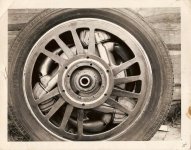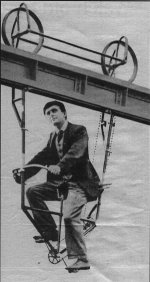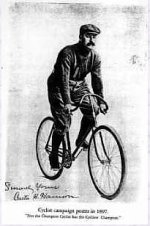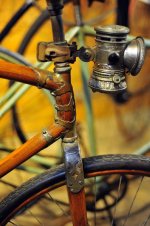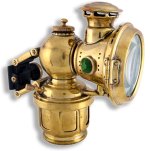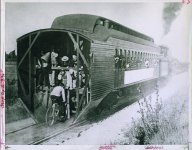Seems to me the real story behind Hotchkiss and his bicycle railroad was Smith...
http://endless-sphere.com/forums/viewtopic.php?f=12&t=8099&start=633
Turns out Hezekiah Bradley Smith was quite a guy. Bicycle-friendly and EVentually playing with motorized trikes too...

Seems he had a good heart... although some folks looked askance at his younger (much younger) second wife(?) and partner in bigamy(?), his coterie of young women later in life who used to get together regularly in the gardens of his mansion (that some jealous reporters termed his "harem")...
View attachment 18
...his pet moose, February, that he trained to pull a cart...

It's hard to say what was most "over the top" for Senator Smith... Call this maybe "Vermont boy makes good"...
His bio from the "Manual of the Legislature of New Jersey", 1885
Burlington County.
Hezekiah B. Smith.
(Dem., Smithville.)
Senator Smith was born at Bridgewater, Vermont, in the year 1816. He learned the trade of a worker in wood, and at the age of nineteen he went into business for himself at Woodstock. Three years later, he took a partner, who, he avers, involved him in bankruptcy. When he was thirty years of age he had paid off all the debts of the firm, and then left Woodstock. He went to Woodburn, near Boston, which was the center of the eastern blind-making trade, with a machine of his own invention that would cut and clean forty mortises a minute. In that town at that time there were five principal blind manufacturers, all of whom were obliged to give up the business within a year. The dealers in blinds in Boston gave him a certificate that his invention had saved over $30,000 annually to buyers, and the Massachusetts Charitable Mechanics' Association gave him a large gold medal, which is yet in his possession. Since then he has taken out a number of patents.
About seventeen years ago Mr. Smith went to a little manufacturing village, two miles from Mount Holly, and bought the manufactory and the houses standing there, which he converted into residences for his workmen. It was then called Shreveville. He expended, it is stated, $300,000 in improvements. He has a natural liking for iron, and 1,200 tons of it have been used in the building of houses and in otherwise improving and ornamenting the real estate. He built a fine hall for the use of the operatives, and employed and paid a band-master, for a number of years, to teach the mechanics instrumental music. He altered the name of the village to Smithville, after himself. A weekly journal, called the Smithville Mechanic, devoted to mechanics, science and literature, he has published there for a long time. Altogether, Mr. Smith estimates that he has invested over half a million of dollars in Smithville. He gives steady employment to over one hundred men the year round, and his manufactory is one of the most thriving industries in that section of the State.
Mr. Smith served as a member of the Forty-Sixth Congress, from the Second New Jersey District. He was a delegate to the National Democratic Convention at Chicago in 1884.
In the session of 1884 he served on the Committees on Agriculture, Lunatic Asylums, Public Grounds and Buildings, and Reform School for Boys.
1879—Deacon, Rep., 5,967; Ridgeway, Dem., 4,888; Axtell, Gr'nb'k, 237.
1882—Smith, Dem., 6,358; Merritt, Rep., 5,370; Abbott, 131.
Another bio from Appleton's Cyclopaedia of American Biography, 1888
SMITH, Hezekiah Bradley, inventor, b. in Bridgewater, Vt., 24 July, 1816; d. in Smithville, Burlington co. N. J., 3 Nov., 1887. He learned the trade of a cabinet-maker, and became an inventor and manufacturer of wooden machinery. He settled in Woodbury, Mass., about 1860, engaged in the manufacture of window-blinds, and invented a machine that cut and cleansed forty mortises a minute, for which the Massachusetts mechanical association presented him with a gold medal. He subsequently took out more than forty patents for original inventions. He established a wood-manufactory in Smithville, N. J., in 1871, which settlement was named in his honor, and spent large sums in building model houses, halls, and places of amusement for his workmen. He was elected to congress as a Democrat in 1878, served one term, and in 1882 was elected state senator, declining renomination.
So his very first patented machine from 1849 actually blew away the competition...

Seen here too:
http://vintagemachinery.org/mfgindex/detail.aspx?id=766&tab=76,343
Apr. 17, 1849
Mortising-machine
Hezekiah B. Smith
Manchester, NH
This was the first patent granted to Hezekiah Bradley Smith, who later founded H. B. Smith Machine Co., which became one of the most important 19th century machinery makers. H. B. Smith was notable for being one of the first to make all-iron machines - others were making machine frames from wood, which is not nearly as stable and rigid. The image of the ad for this "Blind Machine" appeared in "Smithville, The Result of Enterprise". The provenance of the ad is not given, but it is noted that after Smith was granted the patent, "He soon moved to Boston to market his new invention." The machine manufacture was subcontracted to various foundries and machine shops, but he opened his first machine shop in 1851 in Lowell, MA, and he commenced manufacture of his own designs.
From then on, through the 50's and 60's and 70's Hezekiah regularly trounced the competition with award-winning designs for better state-of-the-art wood-working machines...eg:
The American Institute of the City of New York opened their 29th Annual Fair at the Crystal Palace, New York City, on September 15th, 1857...
List of Premiums awarded by the Managers of the Fair:
(Machinery No.3 - Machines for Working Wood, and Models and Drawings for the same.)
H.B.Smith, Lowell, Mass., for the best power mortising machine. Large silver medal.
H.B.Smith, Lowell, Mass., for the best moulding machine. Diploma.
H.B.Smith, Lowell, Mass., for the best small wood planer. Diploma.
Illustrations and Descriptions of Machinery, &c. at the 29th Annual Fair, 1857.
(The descriptions are furnished by the inventors.)

Smith's Power Mortising Machine
H. B. Smith, Lowell, Mass.
These machines are compact, being built entirely of iron and steel, take up but little room, are simple and durable, and have acquired the enviable reputation of being the best machines in use, giving perfect satisfaction wherever used. They run without noise, with no jar on the foot, and the chisel is reversed by power, applied by friction, operating instantly, the chisel always taking care of itself, with no loss of time to the operator, and with no possibility of breaking the machine, they may be run any desired speed with perfect safety.
Size No. 2, is intended principally for door manufacturers, and is capable of mortising any size of stile, or rail, ever required. It is also sufficiently heavy and strong, and suitable for mortising hard wood, such as bedsteads, &c., weighs about 700 pounds, and should be run about 450 strokes per minute.
Size No. 3, is intended for mortising sash and blind stiles, or any light work, thereby taking the place of all foot machines, and does the work nicer, and at least three times as fast, with much less labor to the operator. It weighs about 350 pounds, and should be run about 500 strokes per minute.
[A large silver medal awarded.]
Part of the reason the Smith machines were so good was that he built them entirely out of iron and metals, when many competing firms were still using wood as frames etc in their products...
In 1878, Hezekiah's personal life finally caught up with him... from the New York Tribune, November 22, 1878
ONE WIFE TOO MANY.
A disheartening story comes from New-England, of which the hero is Mr. Hezekiah B. Smith, who has just been elected to Congress by the united efforts of the Democrats and Greenbackers of the IId New-Jersey District. The sum total of the tale is that Mr. Smith has one wife in Woodstock, Vt., and another in Smithville. N. J., where he now resides, and most of which town he owns. In 1866 - so runs the narrative - he ran away from Woodstock, Vt., with Miss Verona Eveline English, and married her in Boston. The pair lived happily together until 1865, and four children were born to them. They resided in Boston and Lowell. In 1850 Smith bought a house for his wife in Woodstock, and frequently visited her there. At last he told her that "he had found a woman who would be true to him and he was going to marry her, his first marriage being illegal." That was in 1865. He gave her a house in Woodstock, put some money in the bank for her and departed. He now turns up as the rich owner of Smithville, and as chief stockholder of the H. B. Smith Manufacturing Company, which makes wood-working machinery. He is also proprietor of The Smithville Mechanic, of which the New-Jersey Mrs. Smith is editor.
If the facts are as we find them stated, the House of Representatives may have some objection to permitting Mr. Smith to take his seat. He is a soft-money Democrat of the strongest sort, and the Republicans will doubtless be quite willing to see his seat empty or filled by a different kind of man. He may be pretty sure that his career will be closely investigated. Whether he legally married Mrs. Smith No. 1 or not, he cohabitated a long time with her in Vermont, and an agreement so to live, by the laws of that State, is a legal marriage without any ceremony. If there has been any divorce the Vermont Mrs. Smith knows nothing about it. She has, it is stated, the sympathy of the people of Woodstock, who consider the treatment which she has received as cruel in the extreme.
Mr. Smith was nominated by the National Labor Greenback party. They sent him a anti-National-bank and anti-capital letter, to which (though he is worth $200,000) he favorably responded. The Democrats kindly lent their assistance and Mr. Smith was elected. But there is many a slip'twixt the cup and the lip; and in these days it is not safe to call any member of Congress blessed until he is sworn in, and sometimes it is not safe even then. It is hinted by the Woodstock correspondent of The Springfield Republican that Mr. Smith may go to Europe rather than Washington, or resign his seat rather than face a prosecution for bigomy. This melancholy catastrophy which has overtaken the Democratic-Greenbackers of the IId New Jersey District will show the danger of nominating candidates worth $200,000, and will be likely to confirm the anti-capital, anti-bloated-bondholder men in their peculiar views. They should go to the alms-house or the insolvent court for their next candidate.
Pic of young hottie Agnes M. Gilkerson, about 1865, the source of so much inspiration and trouble for Hezekiah:
View attachment 14
Beauty, AND brains...
In 1880, his good friend and employee J.J.White introduced Hezekiah and the Board at H.B.Smith Machine Co. to fellow inventor and chicken farmer, Maineiac George Washington Pressey, Jr., and his new idea for an improved velocipede...
Seen here:
http://www.ebooksread.com/authors-eng/h-w-from-old-catalog-wilbur/illustrated-history-of-the-town-of-hammonton-with-an-account-of-its-soil-clima-bli/page-3-illustrated-history-of-the-town-of-hammonton-with-an-account-of-its-soil-clima-bli.shtml
Illustrated history of the town of Hammonton; with an account of its soil, climate and industries.
H. W. Wilbur, 1889
George W. Pressey.
Mr. Pressey is a native of the State of Maine, and was born in Waterville, in 1825. His father was a carriage manufacturer, and by the time the young man was eighteen, he had learned carriage building in all its branches. He early gave signs of an inventive genius, many useful tools having been invented by him. He invented the first apple paring machine, and a carriage spring, known as "Pressey and Farnum's lever spring," a wagon attachment which in its day was deservedly popular. Mr. Pressey came to Hammonton in 1860. In 1867 he invented the "Pioneer Stump Puller," which had a wide use all over the United States. Other inventions which followed were the "Pressey Folding Umbrella," a ventilating stove, and a snath fastener for scythes. But the inventions which have made him best known are the American Star Bicycle, and his incubators and brooders for the artificial hatching and raisins: of chickens. The Hammonton Incubator and the Pressey Brooder have extensive sale and use among poultry men. Mr. Pressey, and his daughters Misses Emma and Anna, are extensively engaged in raising chickens, and have reduced the business to a science. They raised and marketed last year about five thousand.
Georges' 1880 US Patent 233640:

SPECIFICATION forming part of Letters Patent No. 233,640, dated October 26, 1880
It will be noticed that the rider occupies a position nearly central over the hind wheel, the foot-rests of the treadle are within convenient reach of the feet of the rider, and the steering-rod of the fork of the front wheel is set back and its upper end is readily accessible by the rider. By these means the rider sits more comforably, has the velocipede under greater control, and cannot trip or be thrown, and steers with ease.
...and another patent the same year:

In a "Penny-Farthing World" of bikes with large front wheels, Georges' designs were unique, with the smaller wheel in front...
From The Builder and Wood-Worker, September, 1881
The American Star Bicycle.
THIS new candidate for popular favor is the invention of Mr. G. W. Pressey, of Hammonton, N. J., and, as may be seen from the accompanying illustration, is radically different in construction from the old and "accepted" style of bicycle. Mr. Pressey has based his new departure upon the principles of health, safety and convenience and an examination and test of his new plan bicycle, as compared with the older styles, will be convincing as to the soundness of these principles and the advantages of the new system. Among these advantages may be summed up the following: The carrying wheel is held firmly in line by the frame, so the push of the rider does not throw it out of its course. The small steering wheel being in front, serves as a brace to prevent the momentum of the rider throwing him forward when the wheels are stopped or partly stopped by any obstruction, so it can be ridden safely even over logs six or eight inches in thickness. It steers and can be turned quickly, as the push of the rider does not affect the steering wheel, while in turning, a brace is formed on the outside of the circle. It is easily mounted or dismounted. The step being at the side near the saddle, the rider steps easily to and from his seat, instead of climbing up from behind as he must do with the crank machine. There is no bone shaking, both wheels being furnished with fine elastic springs, which add much to the comfort of the rider. It is easy to handle and control, and can be used by ladies in ordinary costume, while the machine is adjustable to the size of the rider, and the latter does not have to fit the machine as in the case of the old styled bicycle. All other bicycles are propelled by cranks turned by the foot, a method of propulsion now out of use in all kinds of machinery; the hand is fitted to turn a crank, the foot is not. If one tries to turn a grindstone by putting his foot on the crank, he will find the experiment a failure. On a six inch crank, a bicycler must make a muscular motion of 37 1/2 inches in order to bear down on his crank an average of less than 4 inches, full power. This is a waste of motion no bicycler can afford. The "American Star," by the use of levers and clutches, has a continuous power, which turns the wheel entirely around with the same motion and exertion required to move the crank one-half around the old machine, enabling the rider to go faster and easier with the same amount of labor, at the same time giving independent action of the levers, the ridier pushing with one foot or both, at pleasure, or setting with foot resting on pedals, which do not move unless he moves them. The name of "Star " is given this bicycle on account of the peculiar arrangement of the wire spokes, which form a double star at the center. By this arrangement the twist of the hub, caused by the pressure of the foot on the crank or lever, is held by the tensional strength of the spoke, which is about 1,000 pounds; while, in the old wheel, the hub is mostly held in place by the bending strength or stiffness of the wire, which is only five or six pounds; the new wheel gaining by this arrangement a strength more than thirty times as great.

The claims are neither fictitious or imaginary. At the recent Boston Bicycle Parade and Meet, in which some half dozen of "American Star" bicycles were exhibited, the great efficiency and practical merits of the new machines were plainly demonstrated to the thousands of bicyclists and visitors who were present, amply proving that the claims made for them are substantiated in actual service.
At this exhibition the new machines came into actual competition with their many rivals, and the result so clearly evinced the superiority of the "American Star," even over the best of its predecessors, as to disarm criticism ard to banish prejudice. The world moves on and the new invention of Mr. Pressey only proves that in mechanical science and genius America leads the van. The "Star" needs but to be introduced to give it the popularity it deserves, and the manufacturers, the H. B. Smith Machine Co.. warerooms 925 Market street, Phila., will be glad to give all needed information and to receive orders for the new season now opening.
The "recent Boston Bicycle Parade and Meet" would have been the first official annual convention for the US L.A.W. (League of American Wheelmen") held in Boston in 1881:

The Watchman and Southron was published out of Sumter, South Carolina so the "exhibition" referred to in their report from December 1881 probably refers to the International Cotton Exposition held late that year in Atlanta, Georgia:
View attachment 9
In addition to entertainers showing off the Star bikes at different exhibitions, Smith had John Stout ride down the steps of the Capitol Building in DC to show how immune the design was to "headers"...

Nice to see some things don't change. Pic of the Capital Building today...

From the journal Knowledge, April 6, 1883
Letters to the Editor
AMERICAN STAR BICYCLE.
[785] - I presume you will easily recall to mind the lecture you gave when in the United States [My third visit thereto. R. P.] before a small but delighted audience in Matawan, N.J., of your subsequent games of chess [King's Knight's gambit - regular form - pretty pawn finish. R. P.], and your early departure the following morning (Sunday) for New Brunswick, to reach a town in Maine for Monday evening's lecture. The memory of every item, of course, lingers with me rather than with you. [Nay, but I have the clearest recollection of that pleasant evening. R. P.] I remember my receiving "Our Place Among the Infinities," as a sort of partial kindly return for a Testament with parallel columns of English and German text, to which I saw you took a liking. Your paper interests me much, from whist and chess, to logic, mathematics, and astronomy. The articles on bicycles and tricyles have also interested me, especially since I have become an owner of one of the "American Star" kind.
I had given up the idea, at my time of life, of ever riding a bicycle. I feared the "headers." But when in Washington, D.C., I saw one of the "American Star" pattern, and immediately ordered one (you will see by the enclosed sketch its peculiarities). I received mine in due time, and must say I am delighted with it. It has the little wheel in front, and one cannot take a "header." In going down steep hills, I can apply the brake, as hard as I choose, with perfect safety and no fear of a "header." It is easy to mount and to dismount, the backward dismount (so called) being especially easy. It can be propelled with one foot, or both at the same time, like a treadle, or at different times. In coasting (i.e., running by gravity down hill), the legs rest at full length on the pedals, and this is especially pleasing. The wheel is stronger than ordinary bicycles, as the spokes are put in bracing, not like radii. You may feel like printing some items from the enclosed. From actual practice over rough roads, I can fully endorse its different points. I will say, however, that it is not as graceful in motion as the ordinary bicycle; but this I regard as a minor point. I have known expert riders of the "Columbia" to sell their machines and purchase the "Star," especially after severe "headers."
I had intended giving a little item about spiders in my schoolroom, but the length of this forbids. Charles Jacobus.
Anyway... those Pressey designs from 1880 were looking a little... rustic...
By 1885 Hezekiah had hired on William S. Kelley, originally from the famous Philadelphia-based woodworking machinery maker Richards, London & Kelley
From Spons' Engineers and Contractor's Illustrated Book of Prices of Machines, Tools, Ironwork, and Contractors' Materials For 1876:

(R,L & K partner John Richards literally wrote the book - several - on the development, design and manufacture of wood-working machinery.)
Kelley designed and patented several wood-working machines for Smith, but also a wire spoke machine in 1884:

...and the next year received patents for two flavours of a much improved Star design:
View attachment 4

Advert for Smiths "The Mechanic" journal in Charles C. Fords Newspaper Manual, October 1885:
View attachment 2
Nice pics of a 1885 Star:


continues...








